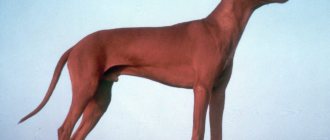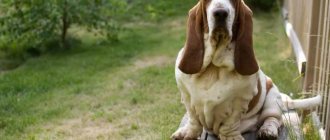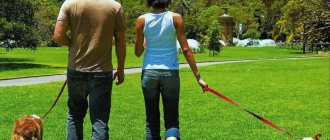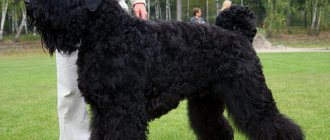When a dog's ears stand up most often depends on the pet's breed and age. Many breeds are distinguished by the fact that their ears are erect. First of all, it gives the dog a certain grace, sophistication and original appearance. However, after fixing the standing position, the animal may encounter certain complications. Which can significantly affect his health.
Thus, in this article there is a need to consider how to install a pet’s ears at home and the main reasons why one ear of a domestic dog is drooping.
Why do you need to put on dog ears?
Straightened and even ears are the main indicator that the dog belongs to an elite breed. Dogs with long ears that stick out upward look proud, courageous, and impressive. This is one of the main reasons why dogs' hearing organs need to be erect.
But still, many owners often do not pay much attention to the appearance of their pets’ ears, much less their position. They perceive the puppy as he is. Some breed standards require a straight and hanging position.
If a dog does not have ears, then this may be a physiological feature of the breed. In this case, the owner can correct them. The main thing is to study the features of this process. In any case, the choice should remain with the person; the dog does not care what kind of ears it has, this does not in any way affect its devotion and love.
How to place cropped ears: detailed instructions
Cropped ears that stand beautifully and correctly are considered a real work of art. They should not gather on the head in the form of a “house” or fall on both sides of the head. Ears after cropping can begin to be set only when the cut edge is completely healed.
Option 1 - soft design
The most problematic part of the procedure is the straightening of the cartilage located at the very base of the ear. We will study the algorithm that will be correct when straightening cropped ears using the example of a representative of the Miniature Schnauzer breed.
Table 3. Algorithm for setting the ears of a dog of the Miniature Schnauzer breed.
| Stages | What do we have to do |
| Step 1 | Fix the dog's head and free the ear from hair using a trimmer, degrease the ear with alcohol. |
| Step 2 | Use two fingers to grasp the tip of the ear, then pull it up and slightly back. This is necessary to straighten the cartilage at the base on which the entire ear rests. |
| Step 3 | Twist both ears into a tube one at a time. Right - clockwise, left - counterclockwise. |
| Step 4 | Wrap a wide adhesive plaster around the twisted ear, holding it firmly by the tip. You need to wrap it starting from the base and reaching the tip. |
| Step 5 | Check the cartilage at the base of the ear: it could have become bent during work. Make sure that the ear canal is not closed, the puppy hears well, and the ears do not swell under the patch. |
| Step 6 | The ears wrapped in adhesive tape must be secured together so that they stand straight. At the base they are horizontally wrapped with adhesive tape and connected to each other. Make sure that the design looks natural and the ears stand upright. |
The pet will have to wear the resulting “horns” on its head for 5-6 days. Then the patch is carefully removed. If you were unable to place the ears the first time, they need to be re-wrapped after 1-2 days. Repeat the procedure until the Miniature Schnauzer's ears stand upright.
Miniature Schnauzer puppy
Option 2 - rigid structure
Another way to straighten cropped ears in large breed dogs is to make a rigid frame. These two types pursue the same goals, are similar in execution algorithm, but differ in the necessary materials.
You can build a solid structure with your own hands. For this you will need:
- foam curlers that will support the ear from the inside;
- a wooden stick to avoid getting your hands dirty when applying glue;
- popsicle sticks to guide and hold the ear;
- medical glue for fixing curlers;
- pharmaceutical fabric adhesive plaster for final treatment.
Instead of fabric adhesive tape in this case, construction tape or masking tape will do. It is important to ensure that the glue does not get into the ear hole. The ears, as in the previously discussed cases, must be shaved and degreased with alcohol.
German Shepherd in a tight frame
Dog breeds with erect ears
Dogs with erect ears are beautiful, stately and graceful; incredible energy emanates from them. Their appearance confirms their aristocratic origin, they are truly created for participation in competitions and exhibitions.
Dog breeds with erect ears include:
- Doberman;
- Likes;
- Shepherds: Belgian and German;
- Husky;
- Terriers. The ears are usually erect on the Scottish, Yorkshire, and Toy terriers;
- Australian Cattle Dogs;
- Spitz;
- Boxer;
- Miniature Pinscher.
But it’s still worth remembering that husky puppies can have floppy ears at an early age; this is often observed in German shepherd puppies. This is a normal phenomenon; gradually, during the process of growth, the cartilage will strengthen, and the ears will fully form and rise.
Nowadays absolutely any breed may require ear glueing. However, most often owners of such breeds as Shepherd, Doberman and Boxer resort to help.
Important! Before exposing your ears, you should consult with a specialist who already has experience in this field. It is he who will help you choose the correct shape of the ears that will suit the animal, and will also be able to show how the first gluing is carried out.
How do you know if your dog's ear needs to be taped?
So, the owner noticed that the puppy’s ears do not straighten out well, they fall inward towards the top of the head or stick out to the sides, and dangle when walking. Now we need to find out whether the ear can rise on its own or whether gluing is required.
Step 1. Determine if there are any creases
It is necessary to carefully examine your pet's ear. If it collapses at the very base, it definitely needs support. Such an ear will definitely not rise without the help of the owner. It must be completely straightened and glued directly at the base in such a way as to completely prevent it from collapsing. The ear should be vertical.
A standard knob looks like a horizontal section with a very thin layer of cartilage. The ear cannot hold up normally and breaks in this thin place, falling forward. This situation can be prevented by feeding the animal calcium from an early age. But if a crease has already formed or is just emerging, it is necessary to glue the ear.
Dog with a crease in the ear
Step 2. Looking for scars and weak spots
If there are no creases, but the ear still falls down, it is necessary to examine it for scars and weak spots. Such areas inhibit development and prevent the healthy ear from rising. The inspection algorithm will be as follows:
- Squeeze the ear at the base with your thumb and forefinger. Start feeling it from bottom to top with your fingertips.
- Find the weak point that prevents lifting. It could be a small speck or a strip of thin fabric. To make sure this is the right place, pinch the spot between your fingers. The ear will rise and straighten as you hold it in this problem area.
- The spot located in the upper part of the cartilage does not require gluing. It is enough to start giving your pet vitamins to restore cartilage tissue. The ear will straighten and become stronger without outside help.
- If the weak area of the tissue is located in the middle of the ear or at its base, gluing is necessary.
If the owner has not found any weak points, but the ear is soft in itself and collapses completely, gluing will not solve the problem. It is necessary to first carry out a course of restorative treatment with vitamins and calcined products. When the cartilage becomes strong and complete, you can start gluing it if it does not rise on its own by that time.
Puppy with house ears
At what age should ears go up?
All newborn puppies, regardless of breed, are characterized by small ears that are pressed tightly to the skull. During this period, they are shapeless, so it is impossible to accurately determine their position (hanging or standing).
With age, the cartilage tissue becomes denser, and as a result, the ears begin to rise. During this period, the differences between straight-eared and lop-eared dogs become most obvious.
Puppies usually develop ears between 2 and 5 months of age. But still, the exact age depends on the specific breed of dog:
- In Yorkshire Terriers, ear lifting is observed as early as 2 months;
- For a shepherd puppy - at 4-5 months;
- For larger breeds – 5-6 months.
If the ears do not rise within the specified period, then the pet may have some abnormalities or abnormalities. In this case, they will not rise on their own, so the owner can take some measures to ensure that they become erect, rather than lying down. If in a large dog at 3 months they lie in soft rags and do not plan to rise, then active actions can be started already this month.
But it is still worth noting that in some breeds the ears can take a straight position only at 6-8 months. In order not to harm your pet, it is better to first consult with a specialist; he will be able to find the reason for the late raising of shells and identify possible problems.
Important! Sometimes the process of raising a dog's ears can be very slow. The owner must carefully monitor their condition. It happens that everything is restored within a few weeks, but sometimes the ears may fall and not rise again.
When to be wary
If by 7-8 months at least one ear is not standing or both ears are lying like rags, then it will be very difficult to achieve the desired results. Concha placement in adult animals is often performed with the help of a surgeon. But still, in order to prevent dangerous consequences, it is worth considering several situations in which the owner’s help may be required:
- Curvature of the bend line. When raised correctly, the ear begins to bend smoothly and forms an arch. If your tailed pet has an angular line, this will greatly increase the risk of a crease;
- Presence of a fold. If there is little time left before lifting, and a small fold appears on the ear, then you should be wary. A crease or scar often appears in this area;
- Lack of progressive development. If your dog has floppy ears that lie like rags, and they are not going to rise in the near future, then it is better to contact a veterinarian. The specialist will identify the cause and perhaps suggest how to help the pet;
- Long retention of ears in the “house” position. Increased load on the base of the auricle leads to the appearance of a crease. An animal can remain with this ear shape for the rest of its life.
Even if your puppy's ears stand up as they should, they may fall back. Often such phenomena are observed in dogs during the period of teeth change, after the introduction of the vaccine. Veterinarians advise paying special attention to the animal during this period. Usually after a few weeks the vertical position is restored.
How to strengthen ear cartilage
What to do if your puppy's ears don't stand up? The program of action depends on the health and maintenance of the pet. Let us outline its main directions.
Diet optimization
Most often, the problem of “ear growth” occurs due to improper organization of natural nutrition. It is impossible “by eye” to guess the correct dose of healthy products (cottage cheese, sour cream, cartilage) that supply the body with calcium and other important “building materials”.
To compensate for the deficiency of substances responsible for the formation of connective tissue, you first need to examine your pet, and then create a balanced diet. This matter cannot be accomplished without the help of veterinary service workers. There is always a risk of overfeeding with them instead of compensating for the missing components.
But after visiting the clinic with a German Shepherd puppy whose ear has fallen off for some reason, all doubts will be eliminated. The specialist will “adjust” your four-legged friend’s menu according to all the rules of nutrition: with high-quality mineral and vitamin supplements and fiber-forming ingredients. A balanced diet in tandem with a massage will quickly solve the problem.
Gluing
This radical procedure is used to lift and strengthen a “heavy” ear that is twisted, wobbly or drooping. Most often, this affects large puppies with poorly developed muscles and massive ears, forming an obtuse angle at the base.
There are several ways of gluing that will allow you to put on your puppy’s ears:
- Using special veterinary glue Tear Mender or Cherry Knoll Ear Fix (can be replaced with less expensive but safe Bison Textile). You need to apply glue to the upper inner part of the ear plate, fold it in the desired position and hold it until it dries completely for 1-3 minutes.
- Fastening with adhesive tape. Cut small squares from sticky tape. One of them is glued to the inner surface of the hearing organ, at the base of the cartilage. The rest are fixed over him. Then a splint (an ear stick, a cotton cylinder, a roll of gauze) is inserted along the glued strip of plaster and secured with a second layer of plaster squares. To keep the ears parallel, a bridge is fixed between them.
- Installation of wire “crown”. It is better to purchase this device at a pet store and place it on your pet’s head for several weeks. Making a wire frame yourself is labor-intensive and requires skill.
Before manipulations, the ears should be freed from fur, cleaned and degreased.
In order not to cause an allergy, you need to experiment on a small area of skin: apply an adhesive agent to it and wait 2-3 days for the reaction. If the patch or glue turns out to be allergenic for the animal, you can replace it with surgical tape. Typical mistakes when modifying the ears:
- fixation too tight
- production that does not meet the breed standard,
- introduction of infection,
- injury to the skin when removing the patch (to avoid this, the overgrown hair should be cut off along with the adhesive tape).
In order not to harm your pet, it is better to get acquainted with the progress of the procedure using a video that will clearly show the master class.
What to do if your dog doesn't have ears?
To raise the ears of puppies, it is not at all necessary to resort to radical measures; you can try to help the animal at home. Sometimes the laxity of the shells can be temporary; it is enough to take a few simple and important measures that can strengthen the cartilage tissue:
- Review your pet's menu. The animal's diet should contain a lot of calcium; this component is required to strengthen cartilage tissue. You should definitely include natural cottage cheese and goat’s milk in your diet. Gelatin is of great benefit to cartilage, so your pet should be regularly fed jellied pork ears;
- Buy the necessary vitamins. The most suitable vitamin complexes for dogs are Volmar, Kanvit, Kalfefit, Silver Trail, Canina, Beafarm and others. But you should still consult a veterinarian first. If vitamins are selected correctly, they can prevent the development of nutritional deficiencies, and they will also increase the strength of the animal’s bone and cartilage tissues;
- Do not forget about increasing blood supply. Ears can be lifted with a simple massage. To do this, you need to clasp the base of the shell with two fingers, then you need to massage your ears with your fingers, you need to move from the base to the tip. The movements should be slow and smooth, but they should also pull the ear upward.
All of the above recommendations will help your puppy get his ears installed on time without the use of dangerous measures. The main thing is that they need to be performed comprehensively, this will increase efficiency and speed up the process of straightening the ears.
Gluing undocked ears
For small dogs with uncropped ears, it is worth using soft designs. It is fixed with cotton swabs and adhesive tape with a width of 3 cm.
The gluing is carried out step by step:
- The coat should be shaved; for this you need to use a trimmer. The wool is removed from each side of the shell. Its removal is desirable, it can reduce the weight of the ear and make removing the adhesive plaster less painful. The remaining areas can be trimmed with scissors;
- Afterwards, the skin must be treated with an alcohol solution, this will ensure better fixation of the adhesive plaster;
- A piece of plaster is measured, it should be equal to the height of the ear. It should be placed on a flat surface, the non-adhesive side should be at the top;
- The cotton swab is cut into two parts. The finished fixative is placed on top of the adhesive plaster. Two layers of plaster are applied to the stick;
- A blank is assembled from the resulting structure, which must match the shape of the ear;
- The blank is glued to the inner surface of the shell; it should not deform the ear canal;
- Adhesive tape needs to be placed along the base of each ear, each of them should look like a tube. There should be at least 1 cm between the edges; this will facilitate normal ventilation and also ensure a full inspection.
After about 6 days, the blank will need to be removed from the ears. The dog should rest for half a day. After this, the puppy is given a new gluing. The design should be worn until the desired effect is achieved.
Gluing of cropped ears
Puppies' ears are often cropped, especially if they are very long. This procedure is often performed on large breed dogs. But how can you make them straight and erect? In this case, you can use gluing, but it must be done after tightening the seams.
The workpiece is installed in the same way as for the soft structure. But other elements will be used for it:
- Instead of cotton swabs, you should use curlers filled with foam rubber; they need to be glued with medical glue;
- The outer side of the ear should be secured with wooden ice cream sticks;
- When fixing the final design, the adhesive plaster should be replaced with adhesive tape with a strong structure (painting or construction tape will do).
Diseases and methods of their treatment
Only a veterinarian can accurately determine a specific disease based on its symptoms, the cause of its occurrence, and select the appropriate medications and dosages for treatment, after a special study, since many diseases have the same manifestations. However, pets with damaged ears are often treated at home on their own.
Otitis
This name covers several types of ear inflammation. Moreover, they can be caused by various pathogens.
Working dogs often get sick with it: hunting dogs, herding dogs, those who spend time in nature and bathe in various bodies of water. Fold-eared breeds suffer the worst.
The main symptoms at various stages are:
- Pain when trying to open the mouth.
- Discharge from the eyes.
- Deafness.
- Edema.
- Formation of pus.
Treatment of otitis media, even in a mild form, cannot be delayed for a day, since in some cases it develops rapidly and threatens to cause pus to enter the brain. In particularly advanced cases, irreversible consequences such as deafness and even the death of the pet are possible.
There are three forms of otitis media:
- Outdoor . This form develops both as a complication of skin diseases and as an independent problem. In this case, the inflammation is localized to the eardrum. From the very first day it can be identified visually. Most photos show otitis externa.
- The average one is manifested by pinching of the nerves of the muzzle and pain when opening the mouth and yawning. Usually located just behind the eardrum.
- The internal one is the most dangerous, since it will not be possible to accurately make this diagnosis based on the external manifestations of the house. The most common signs are incoordination when walking and swaying eyes.
If you are sure that the animal is developing otitis media, then you can provide first aid to the dog at home. To do this, you need to thoroughly rinse the auricle, remove all dirt and crusts, treat the wounds with brilliant green, if any, and drip a painkiller.
Productive treatment that can not only relieve the primary symptoms, but also remove the cause of the condition. Medicines are prescribed only by a veterinarian after a thorough examination. But all procedures are carried out at home. Typically, otitis media is treated depending on the underlying cause:
- For fungal ear infections, treat them with phosphoric acid.
- In case of purulence , all secreted fluids are removed, and then treated with a disinfecting solution and a course of antibiotics is prescribed.
- Allergies are the easiest to cure. This requires local treatment with special preparations and a hypoallergenic diet.
Otodecosis
Otodecosis is an inflammation that begins after an ear mite penetrates the auditory canal. Already at the initial stages, the reason for the dog’s poor health is clear, since mites live in the skin, gnawing passages and eating particles.
Crusts will form inside and active release of sulfur will begin. Under no circumstances should treatment be delayed, since if the parasites penetrate to the eardrum and further, the animal may become deaf. In the most advanced cases, meningitis develops.
You can save your pet at home by treating the affected area with special anti-parasite medications, which can be found in any veterinary pharmacy. However, if otodecosis is already in an advanced form, you need to contact a veterinarian to do research and determine the extent of the damage caused.
Setting up ears for an adult dog
When a dog turns one year old, the cartilaginous tissue in the auricle finishes forming. If by this age your pet’s ears have not stood up, nothing can be fixed. Neither massages, nor feeding with calcined cottage cheese, nor vitamins will help. Gluing can slightly correct the shape of the ear, but the creases cannot be corrected.
The only way out in this situation is plastic surgery. If the owner wants to make the pet's ears erect at all costs, he will have to put the dog on the surgeon's table. Nuances of the upcoming operation:
- The desired effect is achieved by trimming the animal's skin in the forehead area.
- Sometimes, after the first operation, the ears do not stand up as they should, so you will have to perform a second, and, if necessary, a third.
- The effect of erect ears can also be achieved by sewing a whalebone or implant into the auricle.
At the stage of preparation for the operation, the owner needs to analyze all the pros and cons. Even purebred individuals whose ears were installed through surgery cannot participate in breeding, and the consequences of surgical intervention can be completely unexpected.
An adult Doberman whose head is decorated with a homemade design
Features of long-eared breeds
One of the characteristic features of long-eared breeds is that they belong to the hunting group. The length of the ears affects the ability to hunt, since when walking they will drag along the ground, causing the animal to hear all surrounding sounds more clearly. In addition, it helps them to smell all the smells of other animals and follow their trail.
Long-eared dogs have a cute and friendly appearance
Important! Since these breeds are very mobile and active, obesity should not be allowed to occur. It is better to select the ingredients in the diet and walk the dog often. Special care should be given to cleaning the ears.
Prevention of formation
In order for a puppy’s ears to stand up on time, it is necessary that the body receives all the necessary vitamins and minerals.:
- Add bone meal, fish and kefir to your dog's diet;
- Massage the auricle - this will ensure proper blood circulation and strengthen the cartilage;
- Sudden sounds that need to be made will help. The ear will strain and stand up.
- Monitor the health of the ear and if there are any abnormalities (irritation, redness), take your dog to the veterinarian.
Why don't my puppy's ears go up?
The following factors can slow down or stop the process:
- the pet is not purebred;
- large puppy size;
- weakened immune system;
- period of teeth change;
- stress;
- mineral deficiency.
Even if you bought a puppy with erect ears, they may fall off when moving home. The reason is fear. In an unfamiliar environment, the baby behaves warily. Usually the situation returns to normal after a few weeks.











